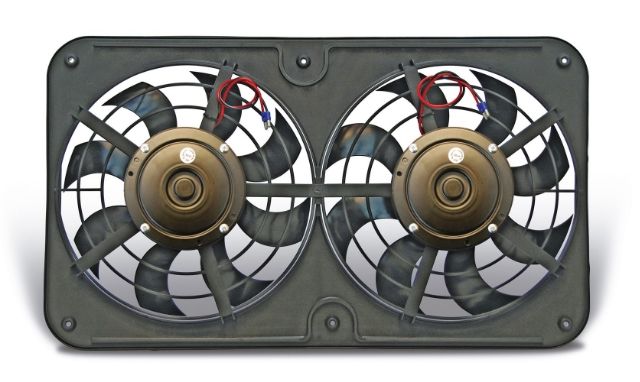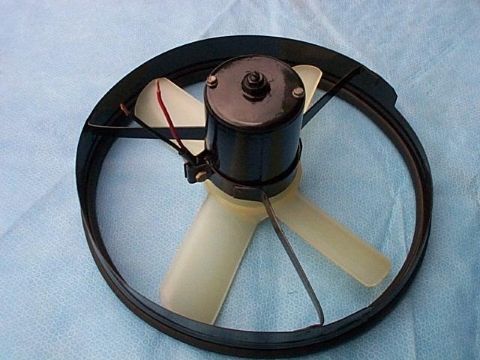If you had to change your rad now, what would you go with - and why?
1 - OEM
2 - Fluidyne
3 - Hall
4 - other?
Replies sorted oldest to newest
David I'm throwing this in mostly for the new guys reading your thread, but I've made comments regarding radiators that apply to your question. It helps to review why we do the things we do.
Cooling system description
The Pantera's cooling system consists of a short list of components:
The 351C controlled bypass high flow cooling system
The 351C was designed to employ a Robertshaw high-flow thermostat as standard equipment and it incorporates a unique high-flow warm-up system Ford called a controlled by-pass system. A high volume of coolant was recirculated within the block (bypassing the radiator) during warm-up. This high flow bypass system prevented the formation of hot spots in the cylinder heads while warming the motor to operating temperature more quickly and more evenly.
Diverting a high volume of coolant away from the radiator would lead to over-heating during normal vehicle operation, so coolant recirculation was controlled (shut-off) once the motor reached operating temperature. This was accomplished via a unique 11/16” OD copper “button” on the bottom of the Robertshaw thermostat which extended downward as the thermostat opened and plugged an orifice in a brass plate mounted inside the block immediately below the thermostat. The addition of the 11/16” OD button to the Robertshaw thermostat makes that particular thermostat unique to the Cleveland engine series. The high flow warm-up and controlled bypass aspects of the cooling system built into the 351C were advanced designs for their day, and cannot be improved upon even today but this unique design makes it imperative to locate and use the proper thermostat. The cooling systems of modern motors have similar functionality, but it is accomplished with a "divorced" thermostat, one that is mounted externally from the engine block. The 351C was unique in accomplishing this functionality internally ... and it was accomplished with only a small modification of the standard Robertshaw thermostat. Unfortunately that small modification has been a major stumbling block.
The Pantera's cooling system woes
The cooling system built into the 351C performs admirably if the proper thermostat is installed. Unfortunately the same cannot be said for the remainder of the Pantera's cooling system. Here's a list of the cooling system's many issues:
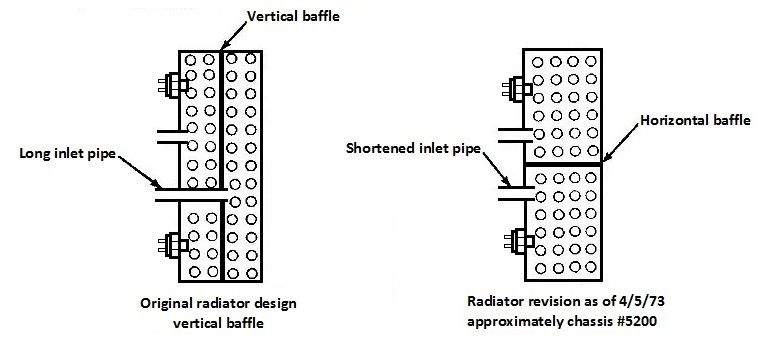
The Pantera is notorious for overheating during stop and go driving. The engine running-on after the key is turned "off" was a secondary problem that annoyed owners. The overheating problem was resolved to a degree by two of the changes mentioned above: (1) revision of the coolant pump inlet plumbing and (2) replacement of the vertical radiator tank baffle with the horizontal baffle. The 1974 L model Panteras could idle all day long without overheating, with the the air conditioning operating, on a summer day ... even with the oem 4 blade radiator fans! Most owners would agree however even the 1974 Pantera's cooling system performance during stop and go driving is perhaps best described as "fragile".
To summarize what ARE the primary causes of overheating:
Subsequent contributors to overheating:
Contemporary causes of overheating
Cooling system specs
Cooling system parts circa 1975
Replacement thermostat
Note: The Robertshaw thermostats have been sold in the past by Stant, Interstate and Prestone using the 333-192 and 333-180 part numbers. The thermostats were also sold by Flow Kooler. The 333-180 thermostat was sold in Australia by Dayco under part number DT66A, and it was sold by Summit Racing under part number BRA-333-180. You should check, but it may not be available from any of those sources any longer. The thermostats have been hoarded by certain businesses specializing in Mustangs, 351C engines, etc. Whenever they become available they are sold out immediately.
Robertshaw 333 series thermostat and the brass plate
that presses into the block below the thermostat
The correct thermostats AND brass plates are available from Marlin Jack.
Marlin is a Pantera owner and a machinist. He manufactured the brass plate
in the picture above. Marlin on eBay
Marlin's email: pantera1974@verizon.net
I do not recommend 160 degree thermostats due to the increase in engine wear. see the chart below.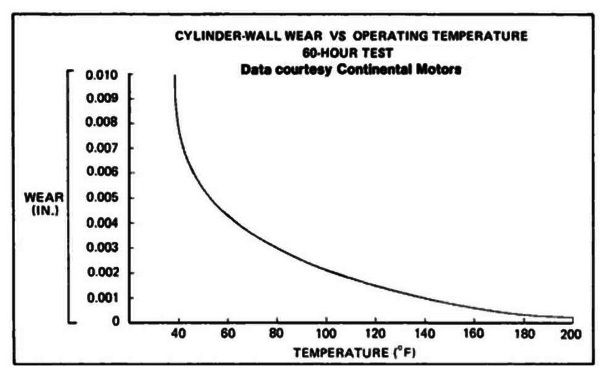
Replacement pressure cap
The pressure cap "neck" of the OEM system tank is designed for European pressure caps, it is taller than a pressure cap neck designed for US pressure caps. Therefore the spring of a US pressure cap is insufficiently compressed and it will not hold the pressure it is rated for. In some cases it will not even seat tightly against the seat. If you cannot find a pressure cap equivalent to the Motorcraft #RS-40 don't despair. You can have a radiator shop replace the European pressure cap neck with a pressure cap neck designed for US pressure caps; or you can purchase an aftermarket tank equipped with the US pressure cap neck out-of-the-box.
Note: The modern replacement for a Motorcraft RS-50A radiator cap is Motorcraft part number RS-62 or Stant part number 10229. The modern replacement for a Motorcraft RL-44 radiator cap is Stant part number 10329.
Refurbishing the OEM Cooling System:
If you follow the steps below your Pantera will have a cooling system that is in May 1973 show-room condition, with one helpful change (elimination of the electric ported vacuum switch) and one helpful addition (a drain cock installed in the top of a radiator tank to make it possible to manually vent the radiator). Don't be concerned about disabling the vent line in order to install the drain cock, because the vent system never worked anyway; this is why it is necessary to manually vent the radiator in the first place. If you do nothing else to the cooling system one mechanical problem shall still exist, i.e. the coolant flow rate shall still be too low. The three electrical problems of the radiator fans are also left unresolved: (1) the fan controls supply the fan motors with power routed through the ignition switch, (2) the fan motors can back feed power to the ignition when the key is turned off, and (3) the fans are always "on" instead of cycling "off" and "on".
Make sure your Pantera's cooling system incorporates these factory revisions:
Helpful changes:
Refurbish:
The Hall Pantera Phoenix radiator makes a practical replacement for the oem radiator for 3 reasons: (1) its less finicky about coolant chemistry because its made of copper, (2) it looks and functions like the oem radiator, and (3) it has an "open" core design that offers low restriction to air flow, making it ideal for use with oem style pusher fans.
The Hall Pantera Mirriah fans were practical replacements for the oem fans. They were equipped with 10 blade Flex-a-Lite fan blades, Hall claimed they moved four times more air than the oem fans. Hall also claimed they drew only 7 amps per motor even though they moved more air than the OEM fans, which draw 8.8 amps per motor. That's 14 amps total compared to the OEM fans which draw 17.6 amps total or the Flex-a-lite model 220 fan assembly which was also equipped with 10 blade fans but was rated at 19.5 amps.
Unfortunately the Mirriah fans are no longer available. Similar fans ARE available from Cool Cat Corp however. And Flex-A-Lite fan blades can be drill-out to fit the larger diameter shafts of the Cool Cat fan motors. https://www.coolcatcorp.com/product/CoolCatFan38.html
Warning The plumbing for the heater core is routed through the center console and up under the dash board. That plumbing includes some rubber hoses. If one of those hoses should burst while you are driving your Pantera it will fill the interior with steam and you won't be able to see where you are going. There is one particular little hose adjacent to the accelerator pedal, if that one should burst it will scald your right foot with 180 degree coolant, you won't be able to keep your foot on the accelerator OR use the brake pedal. This happened to me, which is why I am emphasizing do not neglect to replace the heater hoses within the passenger cabin as you refurbish the cooling system.
Parts Choices
RADIATOR:
I'm not going to be too adamant about radiators. Regardless if you choose to recore your OEM radiator or purchase an aftermarket replacement, all Pantera radiators seem to be capable of performing the job they were designed to do. Here's some radiator info I've learned along the way.
The extra cooling capacity of an aftermarket radiator will be most beneficial for high load driving (high speed, uphill) and driving in very hot climates. Unless your Pantera is equipped with an early radiator having a vertical baffle, or unless the radiator core is fouled by scale, or unless you drive your Pantera in a very hot climate the radiator is not the problem when the engine overheats during stop and go driving. That problem is most likely a combination of the wrong thermostat, air in the system, hose collapse between the radiator outlet and pump inlet, and insufficient coolant flow. For instance, an aftermarket radiator full of air is no more effective at cooling than the OEM radiator full of air. This is not to say the extra cooling capacity of an aftermarket radiator combined with the higher air flow of aftermarket fans may not help a cooling system that is marginal during stop and go driving ... it may ... but it does not address the primary source of the problem.
The choice between copper or aluminum for a radiator should not be a point of argument. Race car builders like aluminum mainly because it is lighter, although there are choices in core design available in aluminum that aren't available in copper. Aluminum radiators can withstand a bit more cooling system pressure than copper radiators because the way in which they are assembled is sturdier than the tin-lead solder used to assemble copper radiators. Today's new car manufacturers have turned to aluminum because it is less expensive than copper. Both metals radiate heat well and both are suitable for use in building radiators. Copper radiators are less prone to being damaged by the condition and chemistry of the coolant, but they are heavier than aluminum radiators and usually more expensive.
The extra cooling capacity of an aftermarket radiator having a thicker core than the OEM radiator will make the cooling system more rugged for high heat load applications, such as driving uphill over a mountain pass on a hot summer day. It is also beneficial for racing or continuous high speed driving. The usual choices in aftermarket radiators include the Phoenix radiator sold by Hall Pantera (copper), the Ron Davis radiator sold by Pantera Performance Center (aluminum) or the Fluidyne #FHP35-PAN radiator sold by everyone else (also aluminum). I must emphasize however the extra cooling capacity of these radiators may not improve cooling problems which occur during stop and go driving.
Left Picture: The Hall Pantera Phoenix radiator;
Middle Picture: The Fluidyne radiator (older FHP30-PAN version);
Right Picture: The Ron Davis radiator
According to Evan's Cooling a radiator the size of the Pantera's radiator with about a 3" to 3-1/2" thick core (i.e. the core thickness of the aftermarket radiators) is good for up to 500 BHP under racing conditions; that should be all the cooling capacity a street operated Pantera shall ever need. As a radiator's core becomes thicker the more it impedes the flow of air. Making the radiator core of a Pantera thicker than 3-1/2" "may" actually hurt the cooling system's performance during stop and go driving by reducing air flow. A custom radiator equipped with a thicker core should pose no problem however for a Pantera race car.
Radiators must be mounted loosely in rubber. There must not be any solid attachment to the chassis, they must be independent of the chassis so any twisting or flexing of the chassis is not transferred into the structure of the radiator.
TANKS AND PIPES:

Stainless steel tanks and a stainless steel coolant pipe kit (1-3/8" OD or 35mm tubes).
If your Pantera needs new tanks or pipes, these should be a life time investment.![]()
This is a 35mm x 38mm silicone hose reducing elbow for connecting the 1-3/8"
coolant tubes to the 1-1/2" radiator nipples of the older FHP30-PAN Fluidyne
radiator. The new FHP35-PAN Fluidyne radiator has 1-3/8" nipples.
FANS:
The small 4 blade oem fans move a reasonable amount of air, if you increase the coolant system's coolant flow rate you may find the oem fans are adequate for your application. This is not to say there isn't room for improvement; higher capacity fans will obviously push (or pull) more air through the radiator during stop and go driving and thus improve the performance of the cooling system when its needed most. There are 4 ways to install replacement fans in a Pantera.
Although fans mounted to the front of the radiator are not as common as fans mounted to the rear, the front mounted fans offer four benefits: (1) oem appearance (2) the radiator can remain up-right (3) no shroud is necessary (4) the fans and the radiator plumbing do not interfere with one another.
Spal is an Italian manufacturer of electric fans that are commonly used and respected throughout the automotive industry (OEM applications, professional racing, motorsports and the aftermarket). Spal fans are available in a wide variety of sizes, configurations and air flow ratings. Flex-a-lite is another reputable manufacturer of electric fans based in the USA.
Always mount the fans in such a way that there is a gap of approximately 1" between the fan blades and the radiator core. Mounting the fans too close to the core will reduce the air moving capacity of the fans. Fans should never be mounted directly to the radiator core. The black plastic ties supplied by fan manufacturers for mounting in that fashion will wear against the tubes in the radiator core and eventually create leaks.
The Hall Pantera Mirriah fans mount in the oem brackets
Mounting one or two high volume fans behind the radiator with a fan shroud will optimize the Pantera's cooling system for street use, the shroud spaces the fans properly away from the radiator core to maximize air flow and it assists the fans in drawing air through the entire surface of the radiator; but a shroud should not be used for a race car or a car driven at sustained high speeds, as it will impede air flow through the radiator at high speeds. The most popular option for mounting fans behind the radiator on a shrowd has been the Flex-a-lite model 220 fan assembly mounted behind the Fluidyne radiator. The Fluidyne radiator has straight nipples (hose connections) instead of angled nipples like the oem radiator making installation of the shrouded fan assembly possible. The two 12 inch fans move air at 2500 cfm (combined) and draw 19.5 amps total. The model 220 fan assembly is no longer available from Flex-a-lite however, it has been replaced by the model 420. As far as I can tell the only difference between the two fan assemblies is the model 420 fans have 8 blades each instead of 10, and current draw has increased to 22 amps total. The air flow rating of the fans is unchanged.
PUMP:
I'm not going to be too adamant about coolant pumps other than to say the pump speed needs to be increased! Here's some coolant pump info I've learned along the way:
A coolant pump that flows more coolant at low engine speed should help alleviate over-heating in stop and go traffic. For the best high-flow at low rpm performance the Flow Kooler pump is the way to go, according to several Pantera owners. Flow Kooler coolant pumps have a unique impeller specifically designed to improve low rpm flow. Their 351C pump is p.n. 1648. Stewart components is another pump manufacturer that is highly recommended. Their stage 1 pump for the 351C, p.n. 16143 is advertised to be "high flow" without any further explanation.
The pump for those seeking the highest flow rate possible is the Stewart Components stage 4 pump. The Stewart Components stage 4 water pump flows 160 GPM! If high flow is what you need, that's the pump. Pantera Parts Connection modifies the Stewart Components 351W pump for Clevelands and sells them ready to bolt on (I believe modification involves removal of the back plate and drilling two holes).
If you're going to use the car in applications where it will be run continuously at high rpm consider the Edelbrock #8844 pump, which is equipped with a cast-curved blade impellar. The forte' of pumps with curved blade impellars is high rpm, they don't cavitate until about 7000 rpm, whereas the pumps with stamped steel impellers are cavitating by 5000 rpm. The pumps with stamped impellers still pump coolant when they cavitate, but they consume about twice as much power. The Edelbrock pump saves about 5 bhp at 6000 rpm. Edelbrock makes no published claims of super high flow rates.
If you're going to use the Weiand #8209 coolant pump, the Milodon #16235 (hi vol) coolant pump, or the Milodon #16335 (std vol) coolant pump I recommend drilling out the recirc passages to at least 5/8"; the passages are plugged as the pumps come out of the box. Drilling out the passages will allow the 351C recirc system to function as designed, it will allow you to use the proper thermostat, and your motor will warm up properly.
The Laws of Physics Governing the Performance and Behavior of Cooling Systems
Drawing Detailing the Pressure Zones Within the OEM Cooling System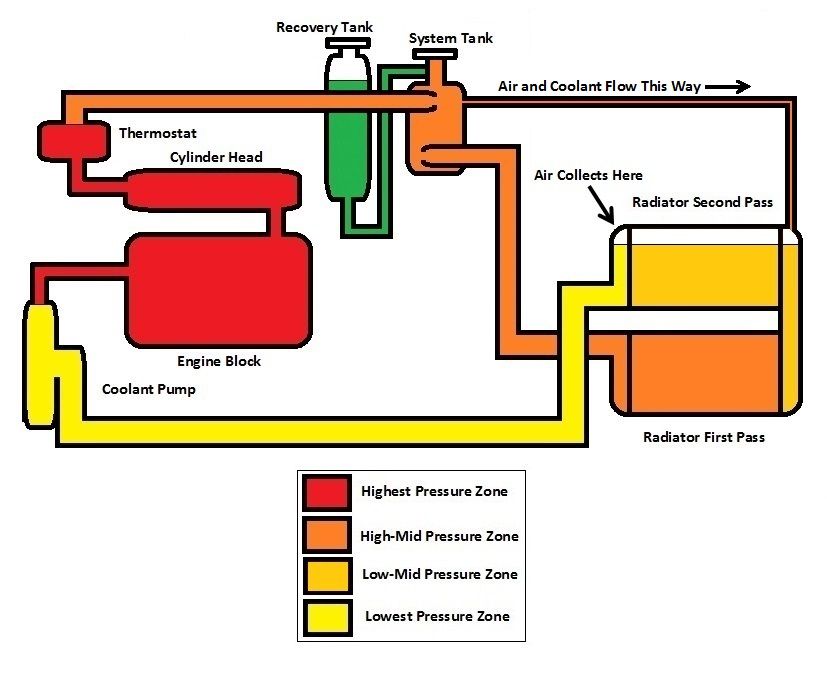
Observations:
Modifying the OEM Cooling System (fixing the problems):
The modifications I am about to suggest compliment the factory revisions mentioned in the refurbishing section; make sure your Pantera's cooling system incorporates those factory revisions. These additional modifications are aimed at two things: (1) correcting the mechanical problems I identified as primary problems with the goal of making the Pantera's cooling system rugged and dependable with the least amount of modification to the car, especially visible modification; and (2) correcting the electrical issues of the fan controls.
(1) Increasing the COOLANT FLOW RATE improves the cooling systems performance during stop and go driving. There are four methods I shall share with you.
(1A) A simple bolt-on way to increase coolant flow is to install a smaller diameter coolant pump pulley to “overdrive” the pump by 10% to 25%. A high quality 4.9" pulley which over-drives the pump by 10% is available from SACC Restorations. Over-driving the coolant pump by 10% is not excessive, there is nothing to fear. The coolant pumps of 351C equipped Ford and Mercury vehicles were also over-driven by 10% when the vehicles were equipped with air conditioning. Feedback from owners who have installed the pulley has so far reported 5°F and 7°F reductions in coolant temperature at idle.
(1B) The second method to increase coolant flow is to install a coolant pump designed to pump more coolant. Some Pantera owners speak highly of the pump manufactured by Flow Kooler (p.n. 1648) which is designed to improve coolant flow at low rpm. Another option for consideration is the Stewart Components pump (p.n. 16143).
(1C) The third method to increase coolant flow involves increasing the size of the plumbing from the radiator outlet to the coolant pump inlet. There is no kit you can buy to do this, you'll have to fabricate the parts yourself using 1-3/4" OD metal tubing. The radiator's outlet nipple should also be replaced with a corresponding 1-3/4" OD outlet nipple.
(1D) The fourth and final method for increasing coolant flow is to install an electric booster pump at the radiator outlet. Stewart Components sells two such pumps for this application, model E558A and model E389A. These pumps are compact and lightweight. They are designed in such a way that if they fail they will not block the flow of coolant in the cooling system; this is a very important feature. Both are rated for 10,000+ hours of operation. I know several owners who have installed booster pumps, and all are happy with the results.
(2) If you would like the VENTING SYSYEM in your Pantera to function automatically (so you don't have to vent it manually) convert the expansion tank to a header tank and plumb the system vents to the header tank. Very little modification is required to make the vent system functional, the tanks appear to have been originally intended for this purpose. The revised plumbing mimics the standard vent system installed in racing cars, and in modern passenger cars too. Feedback from owners who have performed this vent system modification has ALL been positive. Here's a diagram displaying what to do: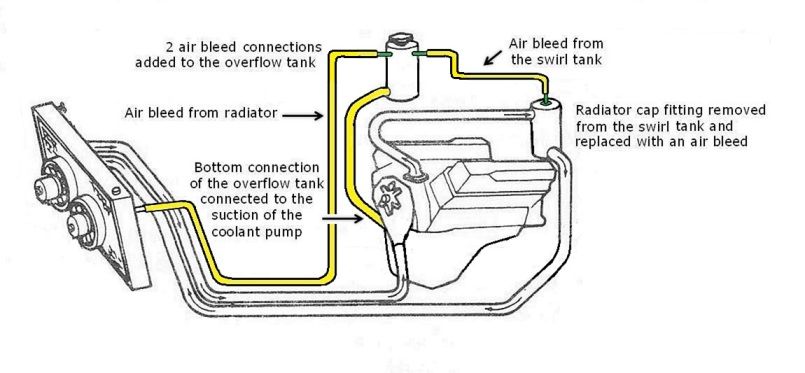

If the tanks are not modified to make the vent system functional, a drain-cock should be installed in the top of one of the radiator's tanks where the fitting for the vent would normally be installed, thus making it possible to periodically vent air from the top of the radiator manually.
Behavior of the Re-Designed System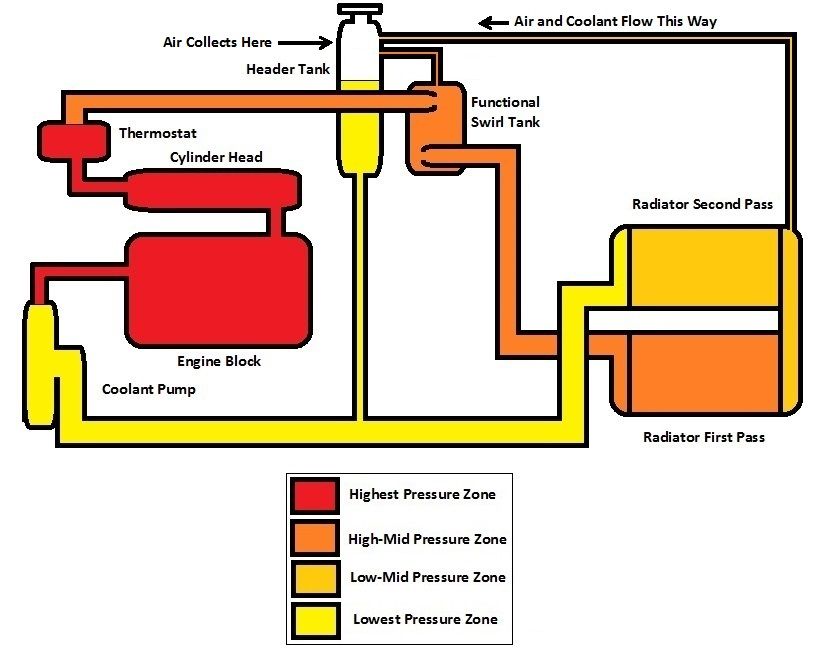
(3) A WIRING REVISION for the fans and their controls, should accomplish 3 things:
It appears the Pantera's radiator fans have always run continuously in the factory installation and in the typical aftermarket installation as well. There is no purpose for this however. If radiator fans run constantly this indicates the coolant never becomes cool enough to reset the fan switches. This could be caused by a cooling system with mechanical issues causing the thermostat to operate wide-open, or this could be caused by fan switches with reset settings which are too low for the thermostat. Assuming the cooling system has no mechanical issues which cause the thermostat to operate wide-open, the fans should turn-off completely when the vehicle cruises non-stop at typical cruising speeds. If the reset settings of the fan switches are too low to allow this then fan switches with higher settings are obviously needed to cycle the fans.
My solution to resolve the issue of the Pantera's constantly running fans is to control both fans with one fan switch so the fans will turn off and on simultaneously; the fan switch shall have a very specific temperature setting allowing it to start and stop the fans in the middle of the operating range of the thermostat. The mid-point of the fan switch operating range should therefore compliment the mid-point of the thermostat's operating range as closely as possible. The fan switch should be located in the radiator's inlet tank (the lower tank) so as to sense the coolant temperature regulated by the thermostat. This solution, as well as solutions for the other two fan circuit problems are reflected in the wiring diagram below.
The mid-point in the operating range of a 192°F (89°C) thermostat is 94°C (fan switches are rated in degrees C). Therefore a fan switch rated at 97°/92° shall best compliment a 192°F thermostat.
The mid-point in the operating range of a 180°F (82°C) thermostat is 87°C. Therefore a fan switch rated at 90°/85° shall best compliment a 180°F thermostat. I have been unable to source a fan switch with M22 threads rated at 90°/85° however, switches with a rating of 92°/87° are the closest I've found.
These considerations are reflected in the switches I've recommended below. Here's the part numbers for name brand fan switches with M22 threads:
Manufacturer...Part Number.........Switch Setting........Thermostat
Intermotor......50190..................100°/95° ..............195°F (91°C)
Intermotor......50104..................97°/92° ................192°F (89°C)
Intermotor......50200..................92°/87° ................180°F (82°C)
Wahler...........823.959.481.F ......92°/87° ................180°F (82°C)
Maintenance:
If you do not perform the vent system modification explained earlier, then you shall need to manually vent air from the top of the radiator as a regular step in maintaining your Pantera. To make this possible a drain-cock should be installed in the top of the raidator's tank where the fitting for the vent would normally be installed.
Fill the cooling system with a 50/50 mix of green Anti-Freeze and water that has had the calcium and magnesium removed. Calcium and magnesium are the minerals that make water "hard" and create mineral deposits and scale. You don't want mineral deposits or scale in your cooling system. If your tap water is naturally low in mineral content you are lucky, go ahead and use your tap water. If not, you'll find several types of water on the market; softened water, carbon filtered water, reverse osmosis water, distilled water, deionized water, double distilled water, high purity water and ultrapure water. Unfortunately the information regarding what type of water to use in a radiator is confusing and contradictory. The ionic state of water is manipulated by any water treatment process; water with an imbalance or depletion of ions can possibly corrode or pit the metal in your cooling system, resulting in pinhole leaks in the radiator core or heater core, so you want to avoid using water with an imbalance or depletion of ions. The chemicals in anti-freeze and coolant treatments are formulated to control some of these problems, but those chemicals are depleted with age and use, so I believe it is wise to fill the system with the best water possible to begin with, the best water being water that will not leave deposits or scale in the cooling system and will not corrode or pit the metal in the cooling system either. Norosion claims softened water is the safest to use, as the calcium and magnesium are removed via an ion exchange process, so the water is not left in an ion depleted condition as it is with other processes. For this reason I place softened water at the top of my list. Reverse osmosis water and distilled water (single distilled) would be the second best choices. Reverse osmosis water and distilled water are normally fed into a deionizing resin bed to produce water labeled deionized, demineralized or high purity. Double distillation is another process used to produce high purity (aka ultrapure) water. Until I learn otherwise I have decided to avoid water labeled deionized, demineralized, double distilled, high purity or ultrapure.
Ron Davis recommends using pre-mixed coolant, i.e. the coolant you buy by the gallon that is already mixed with water. That way which type of water to use (and other chemistry issues) become non-issues.
Other cooling system details include making sure the engine to chassis grounds are clean and tight, and using a coolant treatment like RMI-25, Red Line Water Wetter or Norosion HyperKuhl Super Coolant (blue). The coolant will become corrosive with age and use, this is why the cooling system should be drained and refilled with new coolant every 18 to 24 months unless your coolant treatment specifies otherwise. For instance, Norosion claims if you add their treatment every 12 months you can extend the coolant service interval to 5 years.
The speed of a DC motor is dependent upon the voltage applied to the motor, if full voltage is not applied to the cooling fans they will not run at full speed or move air at their rated capacity. It is imperative to keep the wiring connections to the cooling fans clean and tight to prevent voltage drops across high resistance connections.
Reading: If you want to read more about the design of cooling systems like the Pantera's, refer to Carroll Smith's three books: Prepare to Win (page 122), Engineer to Win (page 170) and Tune to Win (page 97).
-G
quote:OEM rad lasted 24 years. I never had cooling problems so when it sprung a leak I had it repaired for $50.
But instead of putting it back installed a Fluidyne. Can't say it cooled any better but it looked cooler. Anyhow, less than 3 years later it's leaking from 3 or 4 spots. It costs more to repair than buy another one.
quote:Originally posted by garth66:quote:OEM rad lasted 24 years. I never had cooling problems so when it sprung a leak I had it repaired for $50.
But instead of putting it back installed a Fluidyne. Can't say it cooled any better but it looked cooler. Anyhow, less than 3 years later it's leaking from 3 or 4 spots. It costs more to repair than buy another one.
And THAT'S why I went with an OEM style copper/brass radiator. They're proven effective, and can be fixed in short order by any radiator shop or full 'service' gas station anywhere in the country.
quote:Someone had mentioned recently about having the original recored and putting the 'body' of the orginal radiator around it to look and fit like OEM.
Garth, is this what you mean by OEM style?

quote:I noticed in your picture that the top radiator hose is on the driver’s side of the car where both of mine are on the passenger side.



quote:Originally posted by DOES 200:
Here is a shot of the Ron Davis radiator in my Group 4 car. Not a good shot, but too lazy to get the car out of the stacker right now to get a good photo. Dude I got the car from said he had it custom made with Ron, but who knows if that is right or not. It is thicker than the Fluidline I have in my red 5S and has a hose at the top too. Will take photos & measure thickness later when I am sober.
quote:Originally posted by David B:
Okay, let's hear some experienced voices.
If you had to change your rad now, what would you go with - and why?
1 - OEM
2 - Fluidyne
3 - Hall
4 - other?
quote:Originally posted by 1973 Pantera:
I'm still running the stock radiator; it's never been removed from the car since it was installed at the factory 40 years ago. Try that with an aluminum one. My system is stock except for a better dual pusher fan set up. Never any overheating problems at all.
I'm meticulous about changing all fluids every year. My Brake Master Cylinder, Clutch Master Cylinder and Clutch Slave Cylinder all made it 39 years. I'm still running the original 40 year old Brake Calipers and Water Pump.
Change your fluids annually!!
quote:Originally posted by IndyDave:
... They were blown away by the quality. Said it was worth every penny ...
quote:What type of fan did you upgrade to? I'm considering rebuilding my OEM rad that I just pulled out of my 1974 Pantera. I've heard too many stories about the Fluidyne leaking after only a few years...anxious to hear about yours...
John in Fort Erie Canada
